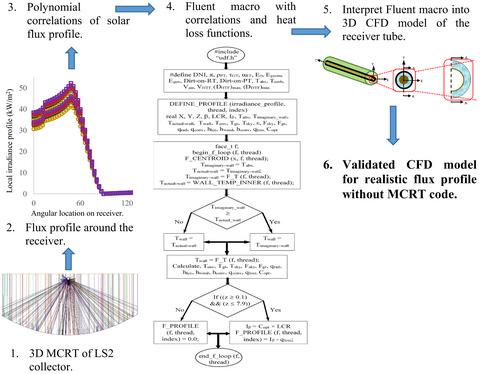当前位置:
X-MOL 学术
›
Energy Sci. Eng.
›
论文详情
Our official English website, www.x-mol.net, welcomes your
feedback! (Note: you will need to create a separate account there.)
A tool to minimize the need of Monte Carlo ray tracing code for 3D finite volume modelling of a standard parabolic trough collector receiver under a realistic solar flux profile
Energy Science & Engineering ( IF 3.5 ) Pub Date : 2020-06-27 , DOI: 10.1002/ese3.741 Majedul Islam 1 , Suvash C. Saha 2 , Prasad K. D. V. Yarlagadda 1 , Azharul Karim 1
Energy Science & Engineering ( IF 3.5 ) Pub Date : 2020-06-27 , DOI: 10.1002/ese3.741 Majedul Islam 1 , Suvash C. Saha 2 , Prasad K. D. V. Yarlagadda 1 , Azharul Karim 1
Affiliation

|
The energy collection element of a parabolic trough collector includes a selective coated metallic receiver tube inside an evacuated glass tube. Perpendicularly incident sun light on the parabolic trough mirror aperture is concentrated on the receiver tube highly nonuniformly along its circular direction. This solar energy is collected as thermal energy circulating a suitable heat transfer fluid (HTF) through the tube. This conjugate heat transfer phenomenon under nonuniform heat flux boundary condition is computationally studied applying 3D finite volume (FV) modelling technique of computational fluid dynamics coupled with Monte Carlo ray tracing (MCRT) optical data. The MCRT model simulates the actual flux profile around the receiver tube. Apart from a FV model, this coupled study requires expertise in, and access to, a suitable MCRT code. A combination of polynomial correlations and user‐defined function (UDF) is introduced in this article in order to minimize the need of MCRT codes from subsequent FV modelling of the receiver tube of the Luz Solar 2 (LS2) collector. The correlations are developed from a verified 3D MCRT model, which is equivalent to the local irradiation data as a function of receiver circular location. The UDF includes two algorithms: one to develop solar flux profile from the correlations around the receiver, and the other to calculate heat loss from the receiver. Interpreting the UDF into ANSYS Fluent, a 3D FV model of the LS2 receiver is developed and validated with experimental results. The effectiveness of the UDF as an alternative to MCRT code is verified. The FV model is capable to investigate the heat transfer characteristics of the LS2 collector receiver at different solar irradiation level, optical properties of the collector components, glass tube conditions, HTFs, inserts or swirl generators, collector length, and internal diameter of the tube.
中文翻译:

一种在实际太阳通量剖面下最小化标准抛物线槽式集热器接收器3D有限体积建模的蒙特卡洛射线追踪代码需求的工具
抛物线槽式集热器的能量收集元件包括在抽空的玻璃管内部的选择性涂层金属接收管。垂直入射在抛物线槽反射镜孔上的太阳光沿其圆形方向高度不均匀地集中在接收管上。收集的太阳能是作为热能,通过管子循环合适的传热流体(HTF)。使用非均匀热通量边界条件下的这种共轭传热现象,使用3D有限体积(FV)建模技术对计算流体动力学进行了研究,并结合了蒙特卡洛射线追踪(MCRT)光学数据。MCRT模型模拟了接收管周围的实际通量分布。除了FV模型之外,这项耦合研究还需要具备适当的MCRT代码的专业知识,并需要获得相应的知识。本文介绍了多项式相关性和用户定义函数(UDF)的组合,以最小化Luz Solar 2(LS2)收集器接收管的后续FV建模中对MCRT代码的需求。相关性是从经过验证的3D MCRT模型中开发的,该模型等效于本地辐射数据作为接收器圆形位置的函数。UDF包括两种算法:一种是根据接收器周围的相关性得出太阳通量剖面,另一种是计算接收器的热损失。将UDF解释为ANSYS Fluent,开发了LS2接收器的3D FV模型,并通过实验结果进行了验证。验证了UDF替代MCRT代码的有效性。
更新日期:2020-06-27
中文翻译:

一种在实际太阳通量剖面下最小化标准抛物线槽式集热器接收器3D有限体积建模的蒙特卡洛射线追踪代码需求的工具
抛物线槽式集热器的能量收集元件包括在抽空的玻璃管内部的选择性涂层金属接收管。垂直入射在抛物线槽反射镜孔上的太阳光沿其圆形方向高度不均匀地集中在接收管上。收集的太阳能是作为热能,通过管子循环合适的传热流体(HTF)。使用非均匀热通量边界条件下的这种共轭传热现象,使用3D有限体积(FV)建模技术对计算流体动力学进行了研究,并结合了蒙特卡洛射线追踪(MCRT)光学数据。MCRT模型模拟了接收管周围的实际通量分布。除了FV模型之外,这项耦合研究还需要具备适当的MCRT代码的专业知识,并需要获得相应的知识。本文介绍了多项式相关性和用户定义函数(UDF)的组合,以最小化Luz Solar 2(LS2)收集器接收管的后续FV建模中对MCRT代码的需求。相关性是从经过验证的3D MCRT模型中开发的,该模型等效于本地辐射数据作为接收器圆形位置的函数。UDF包括两种算法:一种是根据接收器周围的相关性得出太阳通量剖面,另一种是计算接收器的热损失。将UDF解释为ANSYS Fluent,开发了LS2接收器的3D FV模型,并通过实验结果进行了验证。验证了UDF替代MCRT代码的有效性。











































 京公网安备 11010802027423号
京公网安备 11010802027423号